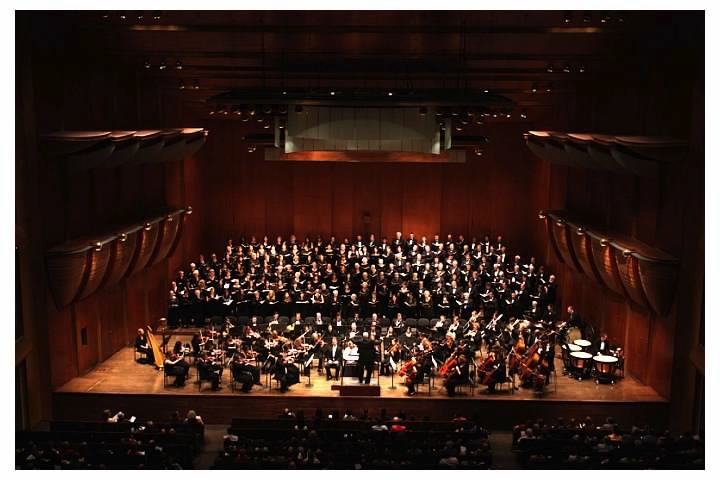On Memorial Day, May 27, 2013, Distinguished Concerts International New York (DCINY) presented a concert entitled “Requiems for the Brave”, dedicated to the men and women of our Armed Forces. With chorus members from Arkansas, California, Connecticut, Georgia, Iowa, Kansas, Massachusetts, Missouri, New Jersey, New York, Ohio, Texas, Canada, and Dubai performing, there was feeling of excitement as the hall filled.
The first half was the Requiem, Op. 9 of French organist, pedagogue, and composer Maurice Duruflé (1902-1986) in the original 1947 version. This serene work is largely devoid of the fearsome elements of the requiem mass (i.e. Dies Irae), but uses Gabriel Fauré’s Requiem as a model. Conductor Jonathan Griffith led the large forces in a highly nuanced performance. His patience at the podium as he waited for the stampede of latecomers to find their seats after the Kyrie was commendable, but after almost five minutes, the Domine Jesu Christe was delivered with a boldness that was worth the wait! The Agnus Dei was delivered with tranquil beauty, and the child-like innocence of the In Paradisum, which ended in a whisper, was breathtaking. Baritone soloist Andrew Garland projected strength and confidence. Mezzo-soprano Holly Sorenson was sublime as she captured the essence of the hauntingly beautiful Pie Jesu. The chorus was very good throughout in what was a well-conceived performance.
During the intermission, The Patriot Brass Ensemble entertained the audience with a steady stream of Sousa marches and patriotic tunes from the balcony. As the singers in the chorus for the second half filed onto the stage, the Patriot Brass ended their set with a medley dedicated to the Armed Forces. It was a strong reminder about what Memorial Day is really about to see the servicemen and women stand when their hymn was played. Some were young, others older, but all proud and steadfast. What was said to them through music was simply “thank you for your service to our nation.”
Mark Hayes (b. 1953) led the second half in performance of his works: the New York premiere of The Gettysburg Address and the World Premiere of his Requiem. About The Gettysburg Address, Mr. Hayes In his program notes writes, “…the challenge of creating something musically profound was overwhelming.” These ten sentences are filled with sadness, hope, challenge, and triumph in what is probably the most famous speech in American History. Mr. Hayes’ conception captures all of these elements, from the bold opening, played with a brash exuberance, to the somber colors of the sorrows of war, to the final build-up in a martial style culminating with repeated declarations of “for the people” from the chorus. It is a powerful work that does justice to Lincoln’s immortal words. After this stirring piece, it was time to pull back into a quieter, contemplative mood, for which the Requiem from Mr. Hayes filled the bill. Dedicated to the memory of Mr. Hayes’ parents, this work takes inspiration from Brahms, Fauré, and Duruflé in its six movements. Mr. Hayes freely uses the English translations of the Latin text in addition to the Latin itself in an interesting and effective way. He parts company with Fauré and Duruflé in a pathos-filled Dies Irae, which did at times bear an uncanny resemblance to O Fortuna from Carl Orff’s Carmina Burana (i.e. substitute Dies Irae/Dies Illa and Confutatis maledictis for O Fortuna/Velut Luna, with the same strong timpani replies, etc.). Baritone Andrew Garland was again a force to be reckoned with in his solo work. The Agnus Dei was to this listener the highlight of the work, showing Mr. Hayes expressive melodic gifts. The final movement, the Lux Aeterna, much like the In Paradisum of Duruflé, ends in a fade to silence. When Mr. Hayes lowered his baton, the audience gave him a richly deserved standing ovation, which ended the successful evening.



